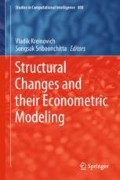Abstract
This study analyzes the factor affecting to foreign direct investment (FDI) inflows in ASEAN countries over the period 2000 to 2016 using Panel Threshold approach and Panel Smooth Transition Regression approach as a tool for this study. In addition, we test the non-linear relationship between the macroeconomic factors and FDI inflow using Akaike Information criteria. The results show that there exists a threshold effect on our FDI regression. In addition, we compare the performance of two non-linear models and find that Panel Smooth Threshold approach perform relative well in our empirical study. The estimation results also suggest that the real effective exchange rate has a negative effect to FDI inflows in good economic condition regimes. Nevertheless, other factors are not show a strong evidence to explain the effect on the FDI inflows.
Access this chapter
Tax calculation will be finalised at checkout
Purchases are for personal use only
References
Ali, A.Y.S., Ibrahim, M.I., Omar, Z.M.: Impact of change in exchange rate on foreign direct investment: evidence from Somalia (2017)
Bilawal, M., Ibrahim, M., Abbas, A., Shuaib, M., Ahmed, M., Hussain, I., Fatima, T.: Impact of exchange rate on foreign direct investment in Pakistan. Adv. Econ. Bus. 2(6), 223–231 (2014)
Eberhardt, M., Presbitero, A.F.: Public debt and growth: heterogeneity and non-linearity. J. Int. Econ. 97(1), 45–58 (2015)
Fattahi, S., Tiatoraj, A., Moshtaghi, N.: Nonlinear relationship between inflation and economic growth. Int. Acad. J. Econ. 3(6), 46–61 (2016)
González, A., Teräsvirta, T., van Dijk, D.: Panel Smooth Transition Regression Models. Research Paper 165 (2005)
Goodman, S.N.: Toward evidence-based medical statistics. 1: the P value fallacy. Ann. Intern. Med. 130(12), 995–1004 (1999)
Granger, C.W.J., Teräsvirta, T.: Modelling Non-linear Economic Relationships. Oxford University Press, Oxford (1993)
Hajamini, M., Falahi, M.A.: The nonlinear impact of government consumption expenditure on economic growth: evidence from low and low-middle income countries. Cogent Econ. Financ. 2(1), 948122 (2014)
Hansen, B.: Threshold effects in non-dynamic panels: estimation, testing and inference. J. Econ. 93(2), 345–368 (1999)
Held, L., Ott, M.: On p-values and Bayes factors. Annu. Rev. Stat. Appl. 5, 393–419 (2018)
Kumar, V.: A study of FDI inflows at world level: an analysis of trends (2013)
Iamsiraroj, S., Doucouliagos, H.: Does growth attract FDI? (No. 2015-18). Economics Discussion Papers (2015)
Levin, A., Lin, C.F., Chu, C.S.J.: Unit root tests in panel data: asymptoticand finite-sample properties. J. Econ. 108, 1–24 (2002)
Nguyen, T.Q., Tob, N.K.: Threshold effect in the relationship between foreign direct investment and economic growth: evidence from ASEAN countries. Asia Pac. J. Adv. Bus. Soc. Stud., Australia (2017). ISBN 978(0), 993656
Pastpipatkul, P., Maneejuk, P., Sriboonchitta, S.: Testing the validity of economic growth theories using copula-based seemingly unrelated quantile kink regression. In: Kreinovich, V., Sriboonchitta, S., Huynh, V.N. (eds.) Robustness in Econometrics, pp. 523–541. Springer, Cham (2017)
Singhania, M., Gupta, A.: Determinants of foreign direct investment in India. J. Int. Trade Law Policy 10(1), 64–82 (2011)
Tibprasorn, P., Maneejuk, P., Sriboochitta, S.: Generalized information theoretical approach to panel regression kink model. Thai J. Math., 133–145 (2017)
Tsai, P.L.: Determinants of foreign direct investment and its impact on economic growth. J. Econ. Dev. 19(1), 137–163 (1994)
Author information
Authors and Affiliations
Corresponding author
Editor information
Editors and Affiliations
Rights and permissions
Copyright information
© 2019 Springer Nature Switzerland AG
About this paper
Cite this paper
Chakpitak, N., Srichaikul, W., Yamaka, W., Sriboonchitta, S. (2019). Determinants of Foreign Direct Investment Inflow in ASEAN Countries: Panel Threshold Approach and Panel Smooth Transition Regression Approach. In: Kreinovich, V., Sriboonchitta, S. (eds) Structural Changes and their Econometric Modeling. TES 2019. Studies in Computational Intelligence, vol 808. Springer, Cham. https://doi.org/10.1007/978-3-030-04263-9_44
Download citation
DOI: https://doi.org/10.1007/978-3-030-04263-9_44
Published:
Publisher Name: Springer, Cham
Print ISBN: 978-3-030-04262-2
Online ISBN: 978-3-030-04263-9
eBook Packages: Intelligent Technologies and RoboticsIntelligent Technologies and Robotics (R0)

